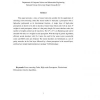153 search results - page 1 / 31 » Neural Network Decoders for Linear Block Codes |
IJCES
2002
14 years 6 months ago
2002
This paper presents a class of neural networks suitable for the application of decoding error-correcting codes.The neural model is basically a perceptron with a high-order polynom...
TIT
1998
14 years 5 months ago
1998
—A sequential decoder for linear block codes that performs maximum-likelihood soft-decision decoding is described. The decoder uses a metric computed from a lower bound on the co...
SIAMDM
1998
14 years 5 months ago
1998
In this paper we present and describe an improved version of the Zero-Neighbors algorithm, which we call the Zero-Coverings algorithm. We also present a method for finding a small...
CORR
2008
Springer
14 years 6 months ago
2008
Springer
In this paper, we propose a partial interference cancellation (PIC) group decoding strategy/scheme for linear dispersive space-time block codes (STBC) and a design criterion for th...
ICC
2007
IEEE
15 years 17 days ago
2007
IEEE
— Most of the existing works on space-time block codes (STBC) assume the channels are quasi-static, i.e., they remain invariant within one block. This assumption is not always tr...


